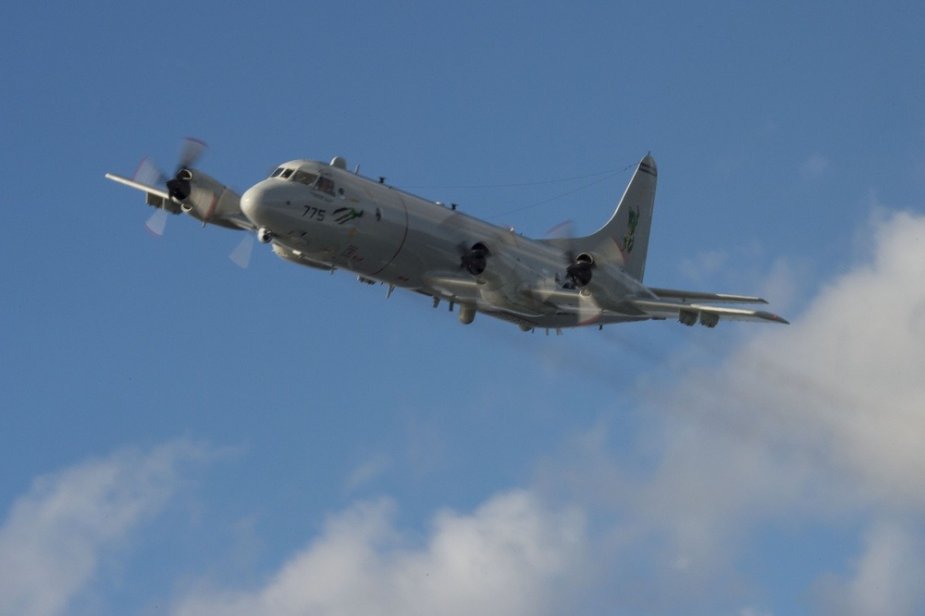Portuguese Air Force enhances maritime security with acquisition of P-3C Orion aircraft from Germany
On Friday February 9, 2024, the Portuguese Air Force took delivery of the first of six Lockheed P-3C Orion aircraft, previously held by the German Marineflieger. This acquisition aims to enhance Portugal's capabilities in detecting and countering undersea threats, an increasingly vital aspect of current maritime security. The delivery of all aircraft is scheduled to be completed within the year.
Follow Army Recognition on Google News at this link

The P-3C Orion, from the U.S. Navy's "Skinny Dragons" Patrol Squadron FOUR (VP 4), performs a flyby alongside the USS Cole (DDG 67) (Picture source: DVIDS)
These six aircraft were initially purchased by Germany to the Netherlands in 2005 and had been in service with the Dutch Naval Aviation Service since 1982, making them nearly 40 years old. Despite the fact that all previous acquisitions were made on the second-hand market, often after multiple cycles of use, Portugal continues to rely on this model to meet its maritime surveillance needs. The first of the six aircraft was officially received in Germany and, after a three-day delay due to logistical constraints, joined its assigned base, Esquadra 601 Lobos, located at Beja in southern Portugal.
The primary mission of these six aircraft, to be delivered by November 2024, is anti-submarine warfare, with the capability to conduct high-sea search and rescue operations. They are set to replace two of the oldest P-3C Orions acquired in 2008 from the Dutch Navy, highlighting a historical irony since these very aircraft were previously sold by the Netherlands to Germany, before being acquired by Portugal. All aircraft are of the P-3C CUP III standard, a version developed by Lockheed in the 1990s specifically for the needs of the Dutch Navy. The ultimate goal of the Portuguese Air Force is to have eight P-3C Orions in service, with two additional units reserved for parts.
Portugal had previously acquired used Orions, notably in 1986 with the purchase of six P-3Bs from the Royal Australian Air Force. These aircraft were locally upgraded to the P-3P standard, a version tailored to Portuguese requirements, to replace the aging P2V Neptunes. Besides the P-3 Orions, the Portuguese maritime patrol also utilizes Airbus DS C295MPA Persuaders, which were purchased new, showcasing the variety of assets deployed to ensure maritime surveillance.
The Lockheed P-3 Orion is a four-engine turboprop maritime patrol and anti-submarine warfare aircraft developed for the United States Navy and introduced in the 1960s. Designed for long-endurance maritime missions, the P-3 Orion has been an invaluable asset across a range of operations from the Cuban Missile Crisis through continuous patrols during the Cold War to recent involvements in Operation Unified Assistance in Southeast Asia, Hurricane Katrina, and Operation Atalanta in the Gulf of Aden. Its versatility and endurance have made it a key player in supporting maritime and terrestrial operations. To maintain its operational relevance, Lockheed Martin initiated a mid-life upgrade program for the P-3, aimed at extending its service life and enhancing its capabilities.
Key variants of the P-3 Orion include the WP-3D, used by NOAA for weather research; the EP-3E Aries and Aries II for electronic intelligence gathering; and the AP-3C, an upgraded version used by the Royal Australian Air Force with modernized mission systems. The CP-140 Aurora serves in the Canadian Forces for long-range maritime reconnaissance and anti-submarine warfare, based on the P-3C Orion airframe but equipped with advanced electronics. The P-3C, in particular, features advanced submarine detection sensors, a sophisticated avionics system for periscope and small target detection, and is powered by four Allison T56-A-14 turboprop engines. With a maximum speed of 411 km/h and a range of up to 4,400 km, the P-3 Orion continues to serve 21 governments worldwide, demonstrating its exceptional ability to adapt to the evolving requirements of maritime surveillance and anti-submarine warfare.
Defense News February 2024
- Hits: 2846
















